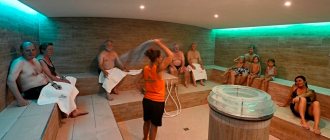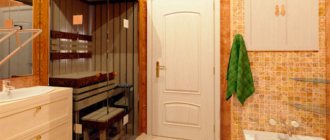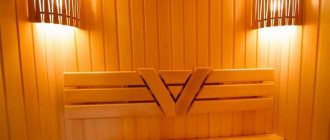Is it possible to go to the bathhouse (sauna) after training?
Sauna is a modern derivative of the traditional and familiar bathhouse, which has long been famous for its ability to have a beneficial effect on human health. Visiting the sauna after training has become especially popular recently, although this issue is very controversial. Of course, after heavy exercise and working on your body, going and relaxing in the sauna is what you need, especially since almost every large gym has its own sauna.
The effect of a sauna is not only a good mood and a feeling of relaxation, but also an internal effect on the body that cannot be noticed just by looking at a person. Therefore, we will describe the effect that a sauna has on the human body immediately after a workout:
- After visiting the sauna, the muscles are renewed twice as fast, due to the fact that the blood vessels, due to the increase in temperature, become more elastic and wider, which makes the heart more active;
- In North America, a study was conducted by regular sauna clients, during which it was proven that a session in the steam room of a gym visit not only relaxes, but also reduces muscle pain due to the fact that endorphin, the hormone of happiness, is actively released. The same experiment also proved that visiting a sauna helps get rid of lactic acid lactate and toxins that are released in the body during training and “slow down” muscle function;
- The sauna promotes comprehensive cleansing of the body: from toxins in the body to pores on the skin, and this is very important for those who train constantly;
- During training, the hormone cartisol is released, which destroys the body. The sauna helps get rid of it;
- The sauna is an excellent solution for those who are overweight and are trying to get rid of it through training and exercise training. The sauna will be a good helper in this matter, because it has been proven that in half an hour you can lose 300 calories here. In addition, under the influence of high temperature, which evenly warms the body, metabolic processes in the body and chemical reactions are accelerated and subcutaneous fat, which often turns into an “orange peel”, disappears faster. As for visceral fat, it is often quite difficult to track its appearance. When stressed, it leaves along with the subcutaneous fluid, so visiting the sauna will help in this case too.
Background
Playing sports and a healthy lifestyle are not a newfangled trend, as many people think. Even in ancient Rome, the cult of a healthy body, as well as a steam bath, was revered. Not only did the Romans engage in sports, but there were thermal baths everywhere - analogues of modern saunas. The most popular types at that time were strength exercises, from which athletics, boxing and wrestling, known today, were formed.
In addition to their love of sports, the ancient Romans also paid a lot of attention to their health and cleanliness of the body. There were thermal baths everywhere, and not only because the Romans considered it necessary to keep the body clean - you could always heat the water and wash yourself.
After grueling training, the citizens of Ancient Rome went to the baths not only to wash themselves, but also to relax, restore blood circulation in tired muscles, and simply chat about politics, culture and life in general. Such a concept as a sauna after the gym would be a completely natural phenomenon for them.
During the USSR, there was also a cult of physical education and sports, but at that time there were no bathhouses at sports complexes. Athletes were limited to taking a shower after training. At the same time, they were considered one of the best in the world. Therefore, it’s worth figuring out what a sauna after the gym is – is it good or bad? And how to properly visit the sauna so as not to harm your health.
Negative and controversial aspects of a post-workout bath
The sauna is a useful place, but if you abuse and neglect some of the rules of visiting the sauna, especially after dynamic training in the gym, the consequences can be disastrous. Therefore, visiting the sauna is not recommended in the following cases:
- For diseases of the cardiovascular system: hypertensive patients whose blood pressure is higher than normal. A sauna can bring such a big “jump” that the blood vessels can’t stand it, and hippotonic patients can get a sharp jump in pressure, which will lead to serious problems;
- People who have skin problems ranging from oiliness to eczema should minimize their trips to the sauna;
- Pregnant women who attend gymnastics sessions should absolutely not visit the sauna after training - this is dangerous for the child;
- You cannot go to the sauna if the workout was more difficult than usual, or lasted more than 45 minutes, this is due to the fact that the load on the body in principle, and especially on the heart, was stronger and it may simply not withstand additional stress in the form of high temperature;
- If you feel constant thirst during training and cannot get drunk, refuse to visit the sauna that day, as this is a direct sign that the body does not have enough fluid, and the sauna is designed to remove this very fluid, so you should not do this “load” the body.
A controversial issue about visiting a sauna after a workout is that studies have shown that weight loss occurs not so much due to fat burning (although this cannot be taken away from the sauna), but due to the removal of fluid, which is essentially not a very good feature. Therefore, many trainers do not recommend their clients to go to the sauna after training. Also controversial is the concept of “cleansing the body,” which has not been proven in any way by science and therefore, many experts dispute this effect and its positive impact on the process of losing weight in principle, calling it nothing more than a “placebo.” Another point that is often disputed about visiting a sauna is the ability to eat properly after a steam bath. Experts place the main emphasis on the fact that after training it is necessary to eat heavily in order to replenish nutrients and trigger muscle anabolism.
Sauna and weight loss
Another persistent myth is that a sauna helps burn fat.
Yes, with its help you can get rid of a few extra pounds, but no more. And only for a short period.
Thermal effects help remove excess fluid, but not fat deposits.
In most cases, the body loses water through sweat, which is safely “drinked” within a few hours after the steam room. And the weight returns to its previous level.
Think logically:
If the sauna had such a powerful fat-burning effect, the whole world would long ago be inhabited by exclusively slim people. You go there once a week, eat as you want and lose weight. The sauna will “burn” everything. Just a dream!
But in reality, everything is much more complicated.
Types of saunas in gyms
Today, almost every large sports complex has its own sauna. Depending on the size of the room allocated for the sauna, the following types of saunas are used in gyms:
- Dry air baths, which are also called “Russian baths”, and Finnish saunas are also often attributed to this type. The air temperature here is from 60 to 120 degrees, and the humidity level is no more than 25%;
- Raw bathswhich are also called steam: the air temperature here ranges from 50 to 70 degrees, and the humidity level can reach 100%;
- Water or Japanese baths assume temperatures up to 50 degrees;
- Infrared bath – a new product among steam rooms, the heating of which occurs due to the radiation of heat rays.
Comparative table of the effects of different types of baths on the body
| Dry air bath | Raw (steam) bath | Water (Japanese) bath | Infrared bath |
| 1. Decrease in body temperature due to rapid evaporation of moisture; | 1. High air humidity prevents rapid evaporation of moisture, therefore, heat transfer is less effective; | 1. Normalization of body temperature due to uniform warming of the body; | 1. Due to the fact that the rays used in an infrared bath are similar to those emitted by the human body, the body overheats evenly, and heat transfer is very effective; |
| 2. No risk of overheating of the body; | 2. High thermal conductivity leads to overheating; | 2. Due to the fact that the temperature of the environment does not change sharply, there are no “jumps” in temperature, which means that there is no additional stress on the body; | 2. The body warms up evenly, so there is no risk of overheating; |
| 3. Dry air does not overload the cardiovascular system; | 3. High load on the heart due to increased body temperature; | 3. Does not have a negative effect on the cardiovascular system, does not cause pressure surges; | 3. Visiting an infrared bath after training has a beneficial effect on the functioning of the cardiovascular system, strengthens blood vessels and normalizes blood pressure; |
| 4. Restoring breathing after training. | 4. Makes it difficult to breathe due to the small amount of oxygen in the air and a large amount of steam. | 4. Does not affect the process of gas exchange in the lungs, it is easy to breathe in such a bath, and the widespread use of essential oils in a water bath helps to get rid of diseases of the respiratory system. | 4. increases the flow of oxygen to all organs. |
What happens to your body when you steam?
Although the operating principles of different types of baths - saunas, thermal baths, hammams - are different, they have approximately the same effect on the body. In a hot room, the body temperature rises, and to prevent overheating, the body begins to sweat. Approximately the same thing happens during heavy physical exertion.
Photo: istockphoto.com
Sweating is a tool by which the body maintains a comfortable temperature for a person. During vigorous exercise or in hot weather, you become hot and sweaty. The released sweat evaporates from the surface of the skin, due to which the body cools.
Seven sweats gone: how to reduce sweating during exercise
How to prepare before going to the sauna?
Before going to the sauna after training, you need to let your body recover from the load for at least a few minutes and only then enter the sauna room. Before entering the steam room, you need to stand for a few minutes under a warm shower, always without soap, otherwise you will wash off the protective layer of sebum from your skin. Be sure to plan your trip to the sauna after training in advance and don’t forget slippers, a cap and gloves if you are going to take a steam bath with a broom. And also stock up on plenty of water, or better yet, herbal tea, it quenches your thirst better.
When you first enter, stay in the steam room for no longer than 5-7 minutes, because the body is exhausted from training and being in an environment with high temperatures for a long time will become stressful and can lead to consequences in the form of dizziness, nausea and even loss of consciousness.
Also, you should not immediately occupy the top shelf ; after stress during training, the cardiovascular system may not withstand a sharp increase in temperature.
As for the use of a broom, everyone must decide for themselves. If you don’t like whipping in the bathhouse, you don’t have to use a broom, but if you are an amateur, then when you first enter the steam room, you can’t beat yourself with a broom; it’s better to start this procedure from the third or fourth session, and even then you need to do it carefully and smoothly.
Turkish hammam
Hammam is a very soft and humid steam room. The temperature reaches 45-55 degrees. Since the steam and temperature in a Turkish bath are very delicate, almost everyone can visit it: pregnant women, athletes with injuries, and people with diseases of the heart and circulatory system (with the permission of a doctor). Hamam is contraindicated for problems with veins and inflammation of the skin.
Benefits of hamam:
- warming up the muscles
- stress management
- relaxation
- body cleansing
- acceleration of metabolic processes
- improved blood circulation
Hammam has a positive effect on the condition of the skin, promotes rejuvenation and fights diseases of the respiratory system. The hammam will perfectly relax your body after a workout.
Visiting rules
Before visiting, you need to take a shower and wash off your makeup. The entry should last about 20 minutes, after visiting you need to swim first in a warm font, and then take a cool shower. You can steam in the hammam up to 3-4 times a week.
Should you go to the sauna before training?
If you are wondering whether it is possible to visit the sauna before training, our answer is definite - it is better to refrain from such activities. This is due to the fact that after a sauna a person has less endurance, which means he will not be able to perform the necessary set of exercises, especially when it comes to strength training. Going to the sauna before exercise will also have an unfavorable effect on the functioning of the cardiovascular system, since high temperature and subsequent physical exercise can lead to overexertion and overload of the body. In addition, the risk of injury during training increases, since relaxed muscles do not work harmoniously. Therefore, to avoid such problems and risks, it is better not to book a sauna before visiting the gym.
Instead of a total
So, there are distinctive features that are characteristic only of a hammam or only of a Finnish sauna:
- Finishing. The classic Turkish bath is a luxurious building with rich decoration. The cladding is dominated by marble or other natural stone, mosaic, and tiles. The Finnish bathhouse is more modest in decoration. Mostly natural wood is used in the interior.
- Heat source. The air in the sauna is heated by a stove or hot stones. In the hammam, the temperature is maintained by heating the walls, floor, and stone benches.
- Air conditioning. In the hammam steam room, humidity can reach up to 100% at a temperature of +45-50 °C. In a dry-air sauna there is no steam, air humidity does not exceed 10-15% at temperatures above +80-100°C.
It is not easy to decide which is better - hammam or sauna. Some people find it physically easier to be in the hot, dry atmosphere of a sauna than in the humid stuffiness of a hammam; for others it’s the opposite. Each bathhouse has its own characteristics, its pros, cons, indications for visiting. However, with proper design and arrangement, both will bring maximum health benefits. Share











